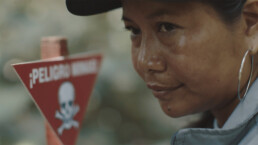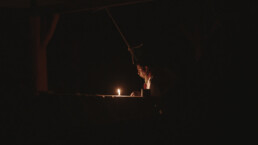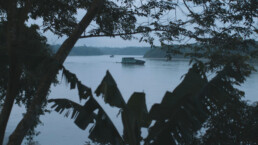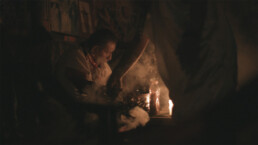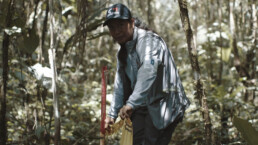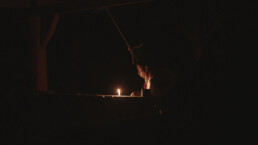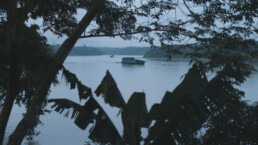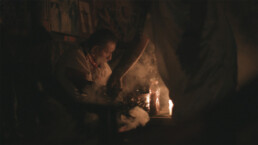La Colaboración De Un Cineasta Con Los Siona Para Contar Su Historia En Defensa De La Amazonía
En este artículo, el cineasta estadounidense Tom Laffay, cuyo cortometraje inspirador “Siona: Defensores de la Amazonía Bajo Amenaza” se estrenó recientemente en The New Yorker, nos lleva al interior de su proyecto cinematográfico a largo plazo con el pueblo Siona de Putumayo.
Las amenazas que enfrentan las comunidades indígenas que viven a lo largo de la frontera de Colombia y Ecuador, como los Siona de Putumayo, son únicas y complejas. Además de las industrias extractivas que invaden la mayor parte de la cuenca amazónica, estas comunidades viven en medio de la violencia a raíz del conflicto armado y del narcotráfico. Siendo Colombia el país más peligroso del mundo tanto para los defensores indígenas como para los activistas por los derechos humanos, abogados o cineastas que los apoyan y acompañan, muy pocas historias de la región llegan a una audiencia internacional.
Nosotros, desde Amazon Frontlines, nos hemos inspirado en el pueblo Siona desde el primer día que bajamos de la canoa en las riberas del río Putumayo a su territorio hace muchos años. Esperamos que su historia crítica sirva para inspirar a otros.
“Siona: Defensores de la Amazonía Bajo Amenaza”, una película dirigida por Tom Laffay por The New Yorker y apoyada por The Pulitzer Center, 2020
Texto de Tom Laffay
“El tigre quitó su piel lentamente, enseñando sus entrañas, había una mancha negra dentro de él. Estaba triste” Taita Pablo Maniguaje, un sabio chamán siona, traduce la visión: “Mi pueblo está en peligro”
Como cineasta, se trata tanto de escuchar como de mirar. Si has pasado algún tiempo en la Amazonía probablemente puedes recordar ciertos sonidos con claridad. El trinar de los pájaros, los monos aulladores, las cigarras y las ramas que caen, la lluvia que fluye intermitentemente todo día, el flujo de cantidades incalculables de agua alrededor. En el territorio indígena siona, a lo largo del río Putumayo entre Colombia y Ecuador, escuchas canciones que han sido cantadas por milenios. Cantos que son poderosos, pero delicados, rítmicos y deliberados. Estos son cantados en una ceremonia de Yagé (Ayahuasca), una antigua práctica de búsqueda de visión guiada por los líderes espirituales de los siona o Taitas. Y en la oscuridad, escuchando la lluvia caer del cielo del Putumayo, tu mente divaga y se asienta, como si estuvieras siguiendo al Taita Pablo por un camino de la selva, hasta su realidad, hasta la historia: pasada, presente y futura.
Por miles de años, los siona han cantado a lo largo de la noche para calmar las lluvias, pedir abundante caza, proteger a los guerreros jóvenes y hablar con los muertos. Ahora, estas canciones están siendo quebradas. Otros sonidos perforan la noche. Un intercambio de armas de fuego o el redoble mecánico de una plataforma petrolífera palpitando a través de la selva alteran el espacio sagrado de la ceremonia. Durante un ritual purificador de la mañana, mientras el sol se filtra a través de las hojas y la selva se despierta, la estridente frecuencia magnética de un detector de minas se mezcla incómodamente con el mundo natural. “Las FARC comenzaron a plantar minas antipersonales dentro del resguardo, donde las familias fueron confinadas y desplazadas. Quiero que el resto del mundo comprenda nuestra situación como líderes indígenas, por reclamar, por exigir ya somos señalados, ya somos desaparecidos. Pero si no tenemos el territorio y no lo queremos, no somos zio bain (siona)”, dice Adiela Mera Paz, la joven líder presentada en la película de The New Yorker, ‘Siona: Defensores de la Amazonía Bajo Amenaza’.
La líder Siona, Adiela Mera Paz, graba un área sospechosa de contaminación por minas como parte de su trabajo para la Campaña Colombiana contra las Minas en el territorio de Siona en diciembre de 2019. Una foto de “Siona: Defensores de la Amazonía Bajo Amenaza”, una película dirigida por Tom Laffay por The New Yorker y apoyada por The Pulitzer Center, 2020
Los siona viven en la entrada noroeste de la Amazonía. “Cuando uno anda por el territorio Siona siente exactamente qué dicen los abuelos que todo eso es vida. Todo tiene vida, un árbol, una hoja, hasta la más pequeñita. Nuestros abuelos nos guían y nos enseñan cuál es la importancia; y el deber de nosotros como zio bain es cuidar y proteger el territorio”, dice Adiela. Su verdadero nombre es Zio bain (en su propia lengua mai´cocá) significa “pueblo del Yagé”, la planta medicinal comúnmente conocida por su nombre en kichwa, Ayahuasca, que significa “liana de los espíritus”. El Yagé es la fuerza guía de los siona y se consume religiosamente en las ceremonias por los Taitas o mayores espirituales, para determinar el camino que su pueblo debe seguir. Es un canal –una ventana hacia el mundo de los espíritus y un maestro que los instruye acerca de cómo vivir bien– que permite a sus ancestros ser guiados por “gente invisible” – guardianes espirituales de la selva y el cielo. Como dice Adiela: “Nuestros abuelos nos han indicado que proviene de una planta sagrada que dicen que es un cabello que viene de dios. [El Yagé] es lo más sagrado que tenemos como pueblo siona. Esto es de mucho aprendizaje, para ser guiados y realizar todos nuestros propósitos”.
En 2009, la nación Zio Bain (siona) fue declarada por la Corte Constitucional de Colombia “en riesgo de extinción física y cultural debido al conflicto armado”, desplazamiento y la presencia de minas antipersonales, junto a otras 33 naciones indígenas que habitan en Colombia. Trece años después, los siona atraviesan su mejor momento organizativo desde que su población comenzó a disminuir a mediados de 1900, y están implementando una atrevida estrategia de defensa territorial. Trabajando junto a Amazon Frontlines y otras organizaciones de derechos humanos están sentando un precedente para las otras nacionalidades indígenas, quienes están aprendiendo de los siona de las técnicas de organización e incidencia con la Comisión Interamericana de Derechos Humanos. Mario Erazo Yaguaje, Coordinador Territorial del Resguardo de Buenavista de los siona, aceptando su responsabilidad, dice: “Somos como un ejército espiritual de mucha humildad, que trasciende hacia lo visible”.
A pesar de una negociación en 2016 entre las FARC y el gobierno colombiano, el país no está en paz. En ningún lugar, es esto más visible que, tal vez, en el departamento de Putumayo, donde los siona han vivido por milenios. Confrontaciones armadas a menudo se suceden dentro o alrededor del territorio siona, dejando las casas acribilladas con agujeros de balas de alto calibre, animales sacrificados y, en algunos casos, miembros de la comunidad siona asesinados. Órdenes judiciales, investigaciones de derechos humanos y reportajes periodísticos serios han sido completamente ignorados por las compañías petroleras que operan cerca del territorio siona, lo cual exacerba los riesgos de violencia por parte de actores armados y amenaza seriamente las vías fluviales, la vida silvestre y la cultura de la que los siona dependen y sobre la que construyen su cosmovisión – una comprensión filosófica y espiritual del mundo.
Deberíamos conocer a los siona y otros pueblos indígenas como objetores de conciencia de la guerra que el capitalismo neoliberal está llevando a cabo sobre nuestro planeta.
Dedico mi vida a informar sobre cuestiones que creo son importantes y a ser un puente para las historias de Latinoamérica. He vivido en Colombia por casi cuatro años, reportando sobre la violencia en marcha contra líderes sociales civiles, quienes muchas veces pertenecen a comunidades indígenas, durante el problemático proceso de paz del país. En 2018, poco después de trabajar en Ecuador donde había hecho amistad con un miembro de la comunidad siona, mi mamá murió de cáncer. Mi nueva amiga me invitó a tomar yagé con ella en ese momento difícil. La ceremonia fue mi introducción a la espiritualidad del pueblo siona, y fue donde, por casualidad, conocí a Mitch Anderson, fundador de Amazon Frontlines. Mitch me conectó con el equipo legal de Amazon Frontlines que trabajaba con los siona. A través de esa colaboración recién nacida, pasé 6 meses en conversaciones con líderes siona y expertos legales, aprendiendo los problemas que afronta la nación siona. En agosto de 2019, fui invitado por Taita Pablo a realizar un primer viaje para “tomar medicina y conversar” sobre las ventajas de hacer un documental con los siona de manera que puedan contar su historia al mundo Occidental. Después de recibir la bendición de los mayores de los siona, comenzamos una colaboración para contar su historia de identidad y espiritualidad dentro del contexto presente. Es una historia intergeneracional sobre diferentes personas, cada una bregando con sus propios conflictos interiores, mientras pelean para reafirmarse como pilares de su comunidad y defender la cultura siona. El corto publicado en The New Yorker es solo el precursor de un largometraje que estoy produciendo en colaboración con el pueblo siona.
Los siona son considerados líderes en la defensa de la Amazonía, una reputación que han ganado mediante la feroz defensa de su cultura espiritual, de la que hay señales en cada faceta de sus estrategias de defensa territorial. “Ellos no juegan según el libro, ellos invierten el guión de los oficiales del gobierno y las compañías de petróleo porque los siona y los Taitas operan en otro plano. Es inspirador, es efectivo y da esperanza a cualquiera que esté a su alrededor”, dijo Brian Parker, abogado que trabaja con Amazon Frontlines. Comunicar la importancia de la cultura y la historia de los pueblos indígenas de la Amazonía desde su propia perspectiva ha sido siempre un mensaje clave de los siona. Y como un joven cineasta con el privilegio de colaborar con los siona, tengo la responsabilidad de comunicar su mensaje a la sociedad Occidental de una manera que atraviese los estereotipos y llegue al corazón de las cosas — a la verdad profunda, trascendente. En palabras de Adiela: “Anhelo y sueño, cuando yo ya este ancianita que haya otras jóvenes que digan ‘estamos defendiendo el territorio’ y este es nuestro legado. Porque sabemos que estamos cultivando el aire, ese aire va servir a un país que de pronto entonces solamente no es para nosotros, es para el mundo”.
Los siona son considerados líderes en la defensa de la Amazonía, una reputación que han ganado mediante la feroz defensa de su cultura espiritual, de la que hay señales en cada faceta de sus estrategias de defensa territorial.
En mi casa en Bogotá, en estos tiempos de aislamiento forzado por el Covid-19, no dejo de pensar en los pájaros mochileros que pasan como un enjambre cada tarde volando por la ribera de la comunidad siona de Buenavista, y, en mi ignorancia, no estoy seguro de si están saliendo a cazar o regresando para finalizar el día. De cualquier manera, ellos construyen los nidos más hermosos, que cuelgan con todo su peso en el calor tropical, y protegen a sus residentes en las tardes cuando el viento barre a través del río y se lleva el calor a otro lado. Es entonces cuando nos acomodamos en nuestras hamacas en la casa de Taita Pablo, cuando está oscuro afuera, cuando todo está quieto, cuando el calor se disipa. Él pone una hoja de plátano en el piso, enciende incienso en la escalera de la entrada de la casa, y tampoco estoy seguro si es para dar la bienvenida a alguien o para mantener a alguien afuera. Su canción inicia, en una tonalidad alta al comienzo; me dijo que estaba hablando “con los espíritus de la lluvia esa noche, para limpiar todo en la tierra y preparar una clara noche de visiones para sus discípulos”– unos diez hombres de la Guardia Indígena con los que estábamos bebiendo Yagé. Taita Pablo canta con fuerza, bendiciendo el espacio que ahora es cálido, mientras la energía se arremolina alrededor con los viajes y enseñanzas de todos los hombres reunidos. Me siento recibido con un acogimiento que solo he sentido antes cuando regresaba a casa a la cocina de mi mamá, recibido por mi hermano y hermana con abrazos y la ofrenda y de comida y bebida. Era lo mismo. Me siento en el suelo frente a Taita Pablo. Mario me anima a reconocer lo que el Yagé me ha dado y a agradecer al Taita. Lo hago, y cerramos el pacto de trabajar juntos para contar la historia que los siona quieren contar al mundo. Tengo la esperanza de que el mundo la escuche.
The Pact: A Filmmaker’s Collaboration With The Siona To Tell Their Story In Defense of The Amazon
In this article, American filmmaker Tom Laffay, whose inspiring short film “SIONA: Amazon’s Defender’s Under Threat” recently premiered on The New Yorker, takes us on a journey into his long-term film project with the Siona people of Putumayo.
The threats facing indigenous communities living along the border of Colombia and Ecuador, like the Siona of Putumayo, are unique and complex. On top of the encroaching extractive industries that plague most of the Amazon basin, these communities live amidst staggering violence from both the armed conflict and the narco-trade. With Colombia standing as the world’s most dangerous country for both indigenous human rights defenders and the activists, lawyers or filmmakers who support and accompany them, very few stories from the region reach an international audience.
We at Amazon Frontlines have been inspired by the Siona from the first day we stepped off the canoe on the riverbanks of the Putumayo River into their territory many years ago. We hope that their critical story and history serve to inspire others.
“SIONA: Amazon’s Defender’s Under Threat”, A film directed by Tom Laffay commissioned by The New Yorker and supported by The Pulitzer Center, 2020
Text by Tom Laffay
“The jaguar slowly peeled back his skin to reveal his entrails, where a black stain was within him. He was sad.” Taita Pablo Maniguaje, a Siona elder and healer, translates the vision, “My people are in danger.”
As a filmmaker, it’s as much about listening as it is about seeing. If you’ve spent any time in the Amazon you can probably recall certain sounds with clarity. The whooping birds, the howler monkeys, the cicadas and the falling branches, the flowing rain on and off all day, the surrounding flow of incalculable quantities of water. In Siona indigenous territory along the Putumayo River between Colombia and Ecuador, you hear songs that have been sung for millenia. Chants that are powerful yet delicate, rhythmic and intentional. These songs are sung in Yagé (ayahuasca) ceremony, an ancient vision quest practice led by the Siona’s spiritual leaders, or Taitas. And in the darkness, listening to the rain fall from the Putumayo sky, your mind wanders and settles, as if you’re following Taita Pablo down a jungle path, into his reality, into history— past, present and future.
For thousands of years, the Siona have sung throughout the night to ease the rains, call for plentiful game, protect young warriors and speak with the dead. Now, the songs are being broken. Other sounds pierce the night. An exchange of machine gun fire, or the mechanical drumming of an oil rig pulsing through the jungle, disrupts the sacred space of ceremony. During a morning cleansing ritual, as the sun filters through the leaves and the jungle awakes, the high-pitch, magnetic frequency of a landmine detector mixes uneasily with the natural world. “The FARC started to plant the landmines inside the reservation, where families were confined and displaced. I want the rest of the world to understand our situation as indigenous leaders, when we stand up and make demands, we’re targeted and we’re disappeared. But if we don’t defend our territory and we don’t love it, we aren’t Siona.” says Adiela Mera Paz, the young leader featured in The New Yorker film SIONA: Amazon’s Defender’s Under Threat.
The Siona live at the entrance to the Northwestern Amazon. “When you walk through Siona territory, you feel exactly what the elders say, that everything is alive. [They] teach us about the importance of our duty as Siona, to care for and protect our territory,” said Adiela. Their true name, Zio Bain (in their own language Mai’Cocá) means “people of Yagé”, the plant medicine commonly known by its Kichwa language name Ayahuasca, which means ‘bitter vine.’ Yagé is the guiding force for the Siona and is drunk in ceremony religiously by the Taitas, or spiritual elders, to determine the path forward for their people. It’s a conduit— a window into the world of the spirits and a teacher instructing them on how to live well— allowing their ancestors to be guided by “invisible people”— spirit guardians of the jungle and sky. As Adiela says, “Our grandparents have told us that Yagé comes from a sacred plant. That it’s a hair given by God. It’s the most sacred thing we have as a people. Yagé is about learning, to be guided and achieve our purposes.”
In 2009 the Zio’Bain (Siona) Nation was declared by the Colombian Constitutional Court as being “at risk of physical and cultural extinction due to armed conflict,” displacement and the presence of landmines, along with 33 other indigenous nations living in Colombia. Thirteen years later, the Siona are more organized than they’ve been since their numbers began to decline in the mid 1900’s, and they are implementing a bold strategy for territorial defense. Working alongside Amazon Frontlines, and other human rights organizations, they are setting a precedent for other indigenous nations, who are learning from the Siona’s organizing techniques and engagement with the Inter-American Commission on Human Rights. Mario Erazo Yaiguaje, the Territorial Coordinator of the Siona Reservation of Buenavista, embracing his responsibility says, “We’re like a spiritual army, a very humble one, converting the spiritual into the visible.”
Despite a 2016 negotiation between the FARC and the Colombian government, the country is not at peace. Nowhere is this more visible, perhaps, than the department of Putumayo, where the Siona have lived for millenia. Armed confrontations often play out in or around Siona territory, leaving houses riddled with large caliber bullet holes, animals slaughtered and, in some cases, Siona community members killed. Court orders, human rights investigations and serious journalistic reporting on this issue have been completely ignored by oil companies operating near Siona territory, exacerbating risks of violence from armed actors and seriously threatening the waterways, animal life and culture that the Siona depend on and base their cosmovision – a philosophical and spiritual worldview. The fight for the Siona’s survival is urgent. Yet the Siona people have mounted a fierce resistance and shown monumental adaptability in maintaining their spirituality and identity through centuries of forced evangelization, colonization, rubber extraction, slavery, narco wars, petroleum extraction and resurgent armed conflict. If anything, we should learn from the Siona and other indigenous peoples as conscientious objectors to the war that neo liberal capitalism is waging on our planet.
If anything, we should learn from the Siona and other indigenous peoples as conscientious objectors to the war that neo liberal capitalism is waging on our planet.
I dedicate my life to reporting on issues I believe are important and to being a bridge for stories from Latin America. I’ve lived in Colombia for nearly four years now, reporting on the ongoing violence against civil society leaders, who are often from indigenous communities, throughout the country’s troubled peace process. In 2018, shortly after working in Ecuador where I had befriended a Siona community member, I lost my mom to cancer. My new friend invited me to drink Yagé with her at that difficult time. The ceremony was my introduction to the spirituality of the Siona people, and it was where, by chance, I met Mitch Anderson, founder of Amazon Frontlines. Mitch connected me with the Amazon Frontlines legal team, which worked with the Siona. Through that nascent collaboration, I spent some 6 months in conversations with Siona leaders and legal experts learning about the issues confronting the Siona Nation. In August 2019, I was invited by Taita Pablo to make an initial trip to “drink medicine and converse” about the merits of making a documentary film with the Siona so they could tell their story to the Western world. After receiving the blessing of the Siona elders, we began a collaboration to tell their story of identity and spirituality within the present context. It’s an intergenerational story about different people, each contending with their own inner conflicts, whilst struggling to stand as pillars of their community and uphold Siona culture. The short film that was commissioned by The New Yorker is just the precursor to a full-length feature film I’m producing in collaboration with the Siona.
The Siona are thought leaders in the defense of the Amazon, a reputation they’ve earned through the fierce defense of their spiritual culture and which is marked in every facet of their territorial defense strategies. “They don’t play by the book; they flip the script on government officials and oil companies because the Siona and the Taitas are operating on another plane. That’s the power of traditional governance rooted in yagé. It’s inspiring, it’s effective and it gives everyone who’s around them hope,” said Brian Parker, lawyer with Amazon Frontlines. Communicating the importance of culture and history to indigenous peoples of the Amazon from their own perspective has always been a key message of the Siona. And as a young filmmaker with the privilege of collaborating with the Siona, there is a responsibility to communicate their message to Western society in a way that cuts through stereotypes and gets to the heart of things— to the profound, transcendent truth. In Adiela’s words, “I dream that our young people will defend our territory. And that will be our legacy. We know that we’re cultivating the air, and that air will help another country that might not always have it. So it’s not just for us. It’s for the world.”
The Siona are thought leaders in the defense of the Amazon, a reputation they’ve earned through the fierce defense of their spiritual culture and which is marked in every facet of their territorial defense strategies.
At home in Bogotá, in this time of Covid-enforced isolation, I keep thinking of the mochilero birds that fly in a swarm every evening past the riverfront Siona community of Buenavista, and in my ignorance I’m not sure if they’re going out to hunt or heading in for the evening. Either way, they build the most beautiful nests, which hang heavy in the tropical heat and protect their residents in the evenings when the wind sweeps through the river and carries the heat off somewhere else. That’s when we settle into our hammocks in Taita Pablo’s house, when it’s dark out, when it’s still, when the heat dissipates. He puts a plantain leaf on the floor, lights incense on the staircase up to the entrance of the house, and I’m also not sure if it’s to greet someone or keep someone out. His song begins, loud at first, he told me he was speaking “to the spirits of the rain that night, to clean everything on the land and to prepare a clear night of visions for his disciples”– some ten men of the Indigenous guardia (land patrol) we were drinking Yagé with. Taita Pablo sings strongly, blessing this space which is now warm, as energy swirls around with the journeys and teachings of all the men gathered. I felt welcomed in an embrace I’ve only felt before when returning home to my mom’s kitchen, welcomed by my brother and sister with embraces and the offer of drink and food. It was the same. I sit on the floor in front of Taita Pablo. Mario encourages me to recognize what the Yagé had given me and to thank the Taita. I do so, and we make our pact to work together to tell the story the Siona want to tell to the world. I hope the world will listen.
